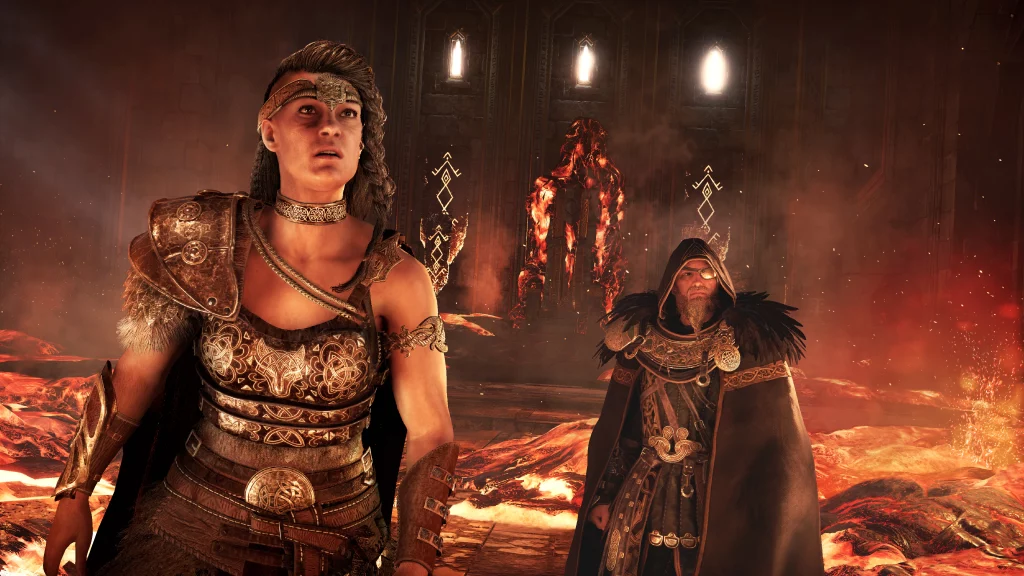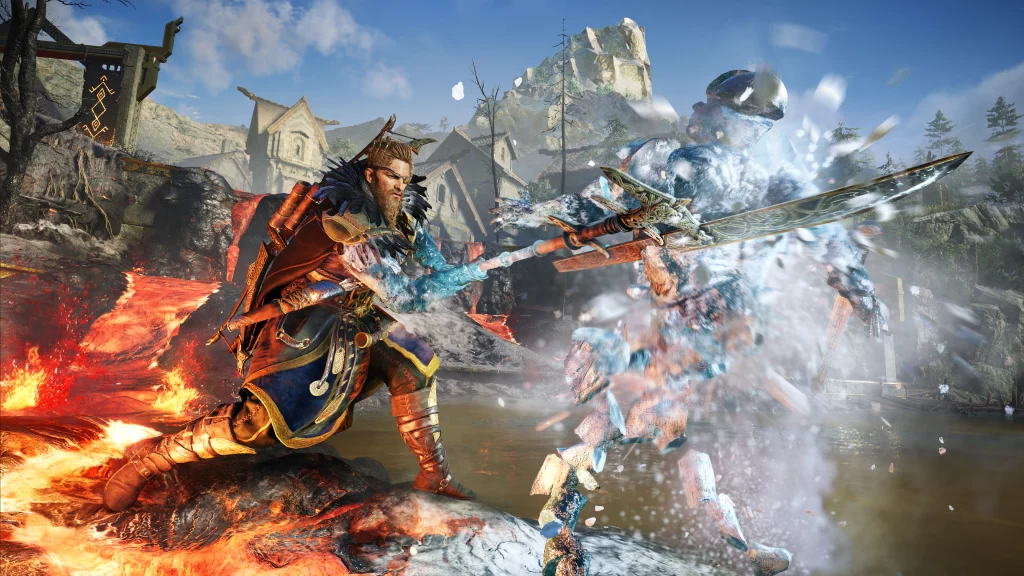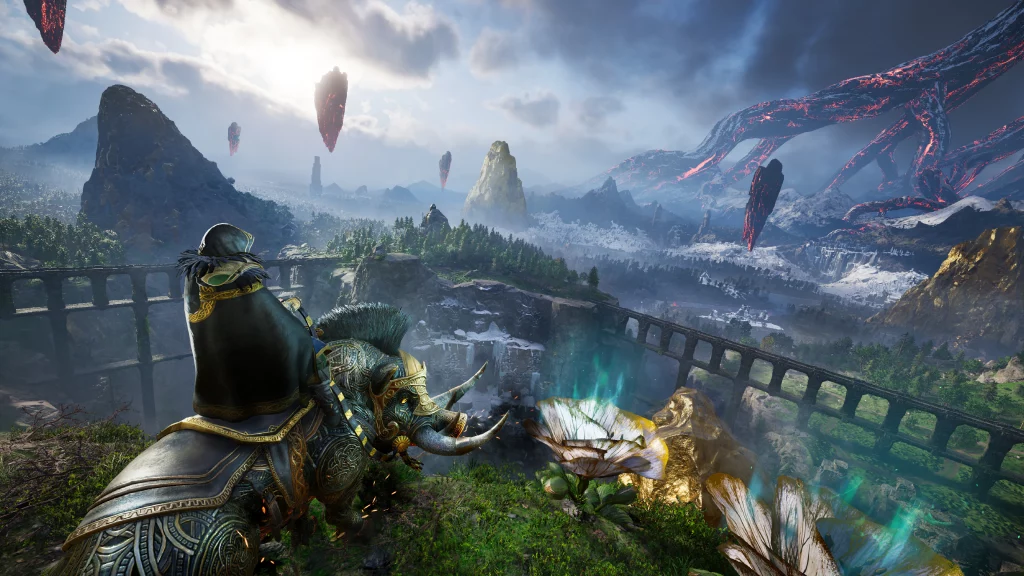REVIEW : Assassin’s Creed Valhalla: Dawn of Ragnarök (XBOX Series X)
Svartalfheim’s once-green terrain is now covered in lava, snaking past majestic, towering Tolkien-esque figures and gold mountains. The sky is now filled with molten bits that bear down ominously from above. This dwarven kingdom has been ripped apart by flaming invaders, and Odin, the ostensible defender of the Nine Realms, has done nothing to stop it. The Norse deity has finally arrived to confront the marauding Muspels – but only in pursuit of those who have kidnapped Baldr, a cherished son.

Valhalla’s dreamworlds, the game’s mythology-inspired places that weave a side tale to the main Norse narrative, have been on my mind for a while. (I’ll do my best to avoid giving any spoilers here.) Most gamers saw Asgard and Jotunheim as a nice detour from the Saxon slaughter, a chance to experience some of the more well-known names and locations from Viking and Marvel Cinematic Universe mythology. They were also a window into the franchise’s longer-running plot lines for Assassin’s Creed fans. Even while the expansion immerses itself fully in fantasy and adds on a new set of features, Dawn of Ragnarök delivers up a more broad mythological plot that is nevertheless grounded and relatable enough for all gamers.
Valhalla’s dreamworlds, the game’s mythology-inspired sections that weave a secondary tale to its primary Norse narrative, have been on my mind for a while. (I’ll attempt to be as spoiler-free as possible.) Most gamers saw Asgard and Jotunheim as a delightful detour from the Saxon slaughter, a chance to visit some of the more famous names and locations from Viking and Marvel Cinematic Universe mythology. They were also a glimpse into the series’ longer-running plot lines for Assassin’s Creed fans. Even while the expansion immerses itself completely into fantasy and adds on a new set of features, Dawn of Ragnarök delivers us a more broad mythical plot that’s nevertheless grounded and relatable enough for all gamers.
Havi journeys to Svartalfheim in Dawn of Ragnarök to save his son from Surtr, Muspelheim’s burning Isu warlord. Surtr has attacked the dwarven homeland with an army of giants drawn from both the frigid Jötunheim and the scorching Muspelheim for an unknown reason. Despite his lack of enthusiasm in discovering what that objective is, Havi finds himself assisting the besieged dwarves in order to get the help he needs to save his kid.
Svartalfheim is a place where you can finally feel like a deity if you play as Odin. Dawn of Ragnarök emerges as a tremendous expansion that expands upon the present Valhalla gear endgame with a wider array of powers, supercharged gear, and dramatic scenery through a new power system and fresh abilities, supercharged gear, and across spectacular terrain. Its tale, which takes place after the fabled elements of the main game but before the much-anticipated Ragnarök, fills in additional details about Odin’s life and intentions. Several faces reappear, some anticipated, some unexpected, to accompany you on your journey. In a few of moments that perfectly finish off the main game, there’s also a bit more from Eivor herself.
Dawn of Ragnarök is largely intended as a post-game addition for those who have mastered Valhalla’s core mechanics and completed the main storyline. Even so, the game’s Asgard and Jotunheim storey arcs are quickly recapped, and you may even leap right into the action (and level up immediately if required) if you really want to. Aside from that, Dawn of Ragnarök stands on its own.
It’s a shame Odin’s kid didn’t get much screen time in the main game, and their relationship wasn’t already formed. There’s little opportunity for this here, though, because Baldr is already abducted when the adventure begins, and the father-son bond is only mentioned in explanatory speech and clumsy text panels.
The campaign tries to work through the complexity of Havi’s abusive behaviour. So far, we’ve only seen a self-proclaimed god who is so convinced of himself that he can’t see any flaws in his acts, reasoning that mistreating his comrades is a necessary evil for bettering Asgard and insuring his eternal life, even through the events of Ragnarök and his planned doom.
Havi is confronted with this element of himself in Dawn of Ragnarök, and the Isu is often given with examples of how the aims don’t always justify the methods. It’s a fascinating hook, but it doesn’t lead to a satisfactory conclusion. His narrative ends abruptly.
Instead, the expansion’s last scenes focus on Eivor, with the premise that the Viking is able to learn a lesson that Havi was unable to. And if Valhalla’s base campaign hadn’t previously ended with a similar conclusion, it would be a fascinating development. So, in the end, Dawn of Ragnarök’s plot seems a lot like the ones recounted in Wrath of the Druids and The Siege of Paris in that it doesn’t go into great detail on narrative elements that have previously been discussed in the previous books.
Dawn of Ragnarök, on the other hand, offers various new concepts to Valhalla’s formula, completely changing how you travel the environment and combat foes inside it.

Svartalfheim is a place where you can finally feel like a deity if you play as Odin. Dawn of Ragnarök emerges as a mighty expansion that builds upon the current Valhalla gear endgame with a new array of fireworks, while centring its version of Odin and letting players delve a little deeper into the mind of its mysterious star through a new power system and fresh abilities, supercharged gear, and across dramatic scenery. Its tale, which takes place after the fabled elements of the main game but before the much-anticipated Ragnarök, fills in additional details about Odin’s life and intentions.
Dawn of Ragnarök is largely intended as a post-game addition for those who have mastered Valhalla’s core mechanics and completed the main storyline. Even so, the game’s Asgard and Jotunheim story arcs are quickly recapped, and you may even leap right into the action (and level up immediately if required) if you really want to. Aside from that, Dawn of Ragnarök is primarily its own adventure, with the search for the previously unknown Baldr serving as the game’s macguffin. It’s a shame Odin’s kid didn’t get much screen time in the main game, and their relationship wasn’t already formed. There’s no time for this here, though, because Baldr is already abducted before the adventure begins, and the father-son bond is only briefly discussed.
Havi is given the Huge Tear early in his voyage across Svartalfheim, a gauntlet that allows him to rip the hugr (a creature’s psyche and emotions) from dead foes and animals and take various shapes and talents. This opens up new possibilities for navigation .Each of the abilities supports one of Assassin’s Creed’s key tenants—parkour, combat, and social stealth—creating fun ways to see how Havi may approach an issue. Havi is similar to Kassandra from Assassin’s Creed Odyssey in that she uses a combination of standard movements and god-like powers to tear thru the outposts with ease and a satisfying display of strength if you’re willing to participate both with movesets and consider carefully how to use each to your benefit.

One of my favourite scenes in Dawn of Ragnarök was when I had to sneak into a Muspel ritual and participate. I turned into a raven and swooped over the opposing camp, reverting back to Havi in midair to air kill a sentry on a watchtower while hiding in a neighbouring woodland. I immediately slew additional soldiers stationed on surrounding roofs with my bow before diving inside a bale of hay and whistling to draw one of the ground guards. I killed him and dragged his body into the hay, absorbing his hugr and changing into a Muspel, exiting the waggon damage-free to stroll through a lake of lava and into the ceremony. It was fantastic. But, for the most part, Dawn of Ragnarök is an expansion to savour, full of huge and tiny stories recounted by fire giants and heroic dwarves and conveyed in a captivating manner. Valhalla’s narrative continues to unfold, and the game’s feast of material continues to expand, but this is the game’s most meaty and demanding addition since launch – and a rewarding course to consume. I was playing the game by hopping on my ride, directing it to travel the path to the next waypoint, then pulling out my phone to do a quick social media doom scroll while waiting for Havi to arrive at his destination on his own by the time I finished Dawn of Ragnarök. That’s a common strategy for getting around Valhalla, but it’s a terrible development considering the circumstances. Dawn of Ragnarök is virtually a game-changer for Assassin’s Creed, hinting at what the franchise may become if it weren’t for the overt hand-holding that has characterised it for over two decades. However, after a promising start, Dawn of Ragnarök slips back into old patterns, and this, along with the fact that the expansion’s narrative themes are too similar to those of the basic game, results in an experience that seems too familiar. However, Dawn of Ragnarök is based on the foundations of a fantastic action-adventure RPG, and that foundation extends through into the expansion, particularly with the rewarding considerations added with the Hugr Rip.














